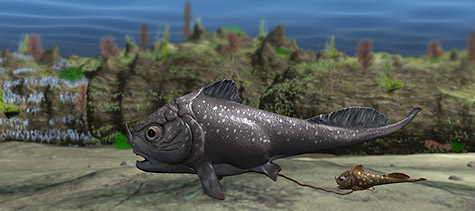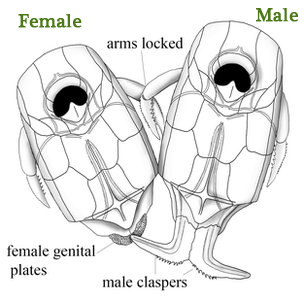Armoured Fish Made a Significant Contribution to Vertebrate Evolution
The placoderms were a hugely diverse and very successful group of fishes, whilst they lasted. For in terms of this groups’ persistence, in geological terms they make a relative short appearance in the history of life on Earth. As a group the placoderms were around for approximately sixty-five million years, not a bad innings but nothing like the longevity of other types of fish such as the sharks, rays and certain actinistians, the Coelacanth for example. The placoderms, or to be more correct, the Class Placodermi first evolved in the Late Silurian and they disappear from the fossil record at the end of the Devonian Period.
Placoderms
Perhaps the most famous placoderm is the giant predator Dunkleosteus. Several species are known and with some specimens estimated to have reached lengths of around ten metres or more, at the time, (Dunkleosteus lived towards the end of the Devonian something like 370 – 360 million years ago), this fish would have been one of the largest vertebrates ever to have evolved.
Dunkleosteus – An Illustration
Picture credit: Everything Dinosaur
Dunkleosteus
Dunkleosteus may have looked like a typical placoderm with its head and thorax covered in articulated armour plate, but the Placodermi, it turns out are being seen as one of the most important group of vertebrates to have existed It is not just because they evolved into the likes of Dunkleosteus, regarded by many as the world’s first, vertebrate, super-predator, but this group of armoured fishes seems to have achieved a number of “firsts” in terms of the Chordata (animals with a spine or spine-like structure in their bodies).
PNSO have added a replica of a Dunkleosteus to the mid-size model series. To view this range: PNSO Prehistoric Animal Figures.
Firstly, palaeontologists have found a number of fossils that suggest that early members of the Placodermi were amongst the first types of vertebrate to evolve a jaw. Recently, Everything Dinosaur wrote a short article about a remarkable fossil discovery form China which reveals some remarkable features: A Jaw Dropping Discovery.
In addition, although the majority of placoderms seemed to have been poor swimmers, with most of them living close to the bottom, a number of families were active and nektonic, indeed these types of fish were the first to evolve paired pelvic fins, a fishy equivalent of legs, although not connected with the spine. Paired pelvic fins are an anatomical feature found in most types of extant fish today.
Plucky Placoderms
Those plucky placoderms may have been amongst the first types of animal to develop teeth. Recently a team of scientists from Australia and Bristol University studying fossilised remains of placoderms from Western Australia found evidence of the first types of teeth, teeth with a structure very similar to our own. To read more about this: The Origins of a Toothy Grin.
Fossils from the same rocks (Go Go Formation) western Australia gave palaeontologists a remarkable insight into the reproductive strategies of many types of ancient fish. One species of placoderm, known from just a single fossil specimen represents the oldest example of a vertebrate capable of giving birth to live young (viviparity). Materpiscis attenboroughi was a small, bottom of the reef dwelling fish whose fossilised remains preserved in a limestone nodule showed evidence of an embryo and an umbilical cord. This was evidence of internal fertilisation within the fossil record and the oldest known case of viviparity.
Materpiscis attenboroughi – A Remarkable Placoderm
Picture credit: Museum Victoria
The remarkable Placodermi may have just added another evolutionary “first” to their string of impressive attributes. A scientific paper published in the journal “Nature” provides details on a fossil discovery that hints at the very first example of copulation amongst vertebrates. The international team of researchers that led the study into the antiarch (an-tee-arc) placoderm called Microbrachius dicki state that this was the earliest animal known from the fossil record to stop reproducing by spawning (external fertilisation).
Materpiscus attenboroughi
Professor John Long (Flinders University, South Australia), was the lead author of the academic paper. The Professor, a renowned expert on Devonian fishes had earlier worked on Materpiscus attenboroughi. The fossils of M. dicki are relatively common. This small freshwater placoderm grew to about ten centimetres in length and lived around 385 million years ago.
Professor Long Explains the Key Points of the Research
Picture credit: Flinders University
Commenting on the research, Professor Long stated:
“We have defined the very point in evolution where the origin of internal fertilisation in all animals began. That is a really big step.”
A Peculiar “L-shaped” Appendage
A close inspection of a fossil revealed that one of the Microbrachius specimens had a peculiar “L-shaped” appendage. Further study revealed that this was the male fish’s genitalia.
The Professor pointed out:
“The male had large bony claspers, These are the grooves that they used to transfer sperm into the female”.
On the other hand, the females had a small bony structure at the rear that helped to lock the male organ in place during mating. Constrained by the anatomy, the fish probably had to mate side by side, a sort of “square dance position” as described by the researchers.
An Illustration Showing the Proposed Mating Position of M. dicki
Picture credit: Flinders University/Nature
However, copulation using this method does not seem to have stayed around for very long in these Devonian fish. As fish evolved, they reverted back to external fertilisation (spawning), whereby male and females release sperm and eggs respectively into the water and fertilisation relies more on chance. It took several more millions of years before the ancestors of today’s sharks and rays evolved copulation.
The Placodermi may be most famous for the likes of Dunkleosteus, but scientists are beginning to realise that these strange, armoured fish may have contributed much more to the evolution of the vertebrates than just the first, back-boned super-predator!










Leave A Comment